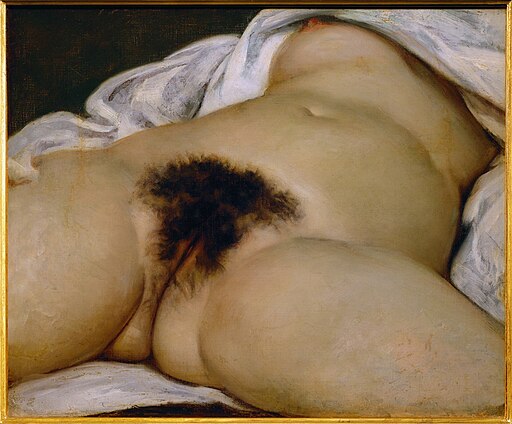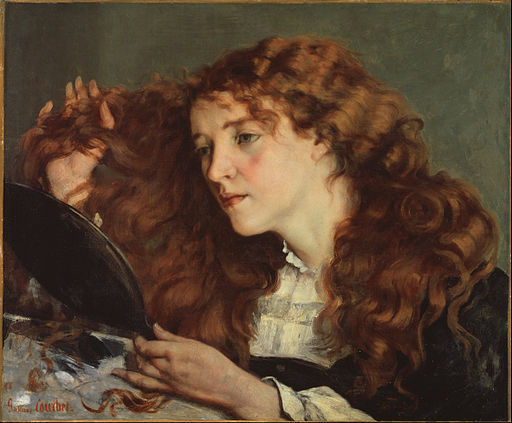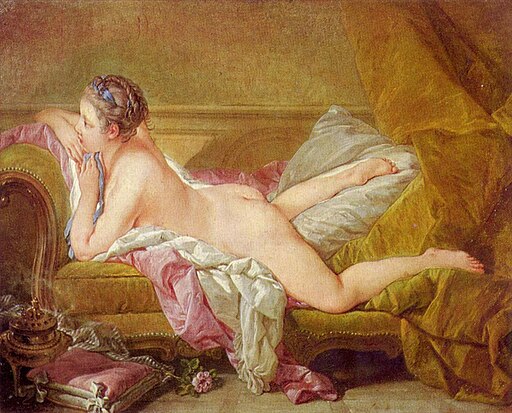So, today is St. Patrick's Day and before we head off to get drunk, we thought we'd just take a moment to explain the significance of this occasion, with a Kinky and Erotic special on an Irish theme and flavour. Not an easy task, you might say, since Sex and the Irish are not exactly two words that fit easily together in the same sentence.
Indeed, The Book of Irish Erotica, if such a title exists, would surely rank with those holding the dubious distinction of being among the shortest books ever written: alongside German Humour, French Hospitality, American Culture, Italian War Heroes, we could go on.
Nevertheless, here at Kinky and Erotic, once we set ourselves the challenge, we don't back down and we have never shirked, in the past, from using any flimsy pretext to serve up smut and sexually-charged innuendo.
Where to begin then? Let's start at the beginning: the very, very beginning or, the origin of the world to be precise.
The attractive young woman depicted here is "the Irish redhead Joanna Hiffernan, who must have been around 23 when this work was painted. Joanna "Jo" Hiffernan (ca. 1843 – after 1903) was also the model of and romantically linked with American painter, James Abbott McNeill Whistler, who painted her as The White Girl. Courbet also painted her as La belle Irlandaise and Le Sommeil."
It was said of Joanna (Jo) Hiffernan that, "She was not only beautiful; she was intelligent; she was sympathetic. She gave Whistler the constant companionship he could not do without."
If you did not recognise her, worry not and no, she's not one of your ex's (unless you happen to be about 150 years old, maybe a vampire). She is, in fact, more familiar to the art world from a somewhat different perspective to that on view in the above piece, thought to be the "long-lost upper section of Gustave Courbet’s masterpiece, The Origin of the World (L'Origine du monde)." Here, in all of its glory and splendour, is the famed lower section.
Ah yes; a more familiar sight, we're sure you will agree.
Ms Hiffernan posed for Courbet in other work, including La belle Irlandaise aka Jo, the Beautiful Irish Girl ...
... and this one, entitled Le Sommeil or Sleep, in which she is to be seen lying naked on a bed with a beautiful female companion, whose name we have been unable to ascertain and thus, have no way or knowing whether or not she was Irish. To be honest, after gazing on it, you probably won't care. We know we don't!
One final painting by Courbet features her as La Femme dans les vagues or The Woman in the Waves, and doesn't she just make waves?
Well, that's almost it for Irish-themed erotica. Frankly, we're surprised that we even got this far. Let us not leave this subject however, without a mention for Marie-Louise O'Murphy (1737-1814), also known as Mademoiselle de Morphy and described as 'one of the lesser mistresses of King Louis XV of France, posing here in this oil and canvas painting by François Boucher c. 1752.
Though born in Rouen, Mlle O'Murphy was of Irish ancestry, as her name most obviously suggests. The fact that she is regarded only as one of the 'lesser mistresses' of the King, might explain why envy leading to resentment among the French peasantry and the lower orders of society generally was common during the reign of the Ancien Regime: it must be remembered that, at the time that we are talking about, many subjects had only cake to eat and certainly did not have such an abundance of choice where mistresses were concerned.
It was this kind of resentment that, no doubt, added fuel to the fire that was to culminate in the French Revolution of 1789, celebrated annually in France as Bastille Day: a solemn remembrance of an action that saw an angry mob storm the notorious prison in the heart of Paris, to liberate the Marquis De Sade, a pair of certified lunatics (one of whom was Irish - a point worth mentioning in this context), together with a motley crew of petty criminals whose main talent was forgery.
Thereth endeth the history lesson for today. Happy St. Patrick's Day. We didn't even get to the part where we explain how he drove all the snakes out!
Indeed, The Book of Irish Erotica, if such a title exists, would surely rank with those holding the dubious distinction of being among the shortest books ever written: alongside German Humour, French Hospitality, American Culture, Italian War Heroes, we could go on.
Nevertheless, here at Kinky and Erotic, once we set ourselves the challenge, we don't back down and we have never shirked, in the past, from using any flimsy pretext to serve up smut and sexually-charged innuendo.
Where to begin then? Let's start at the beginning: the very, very beginning or, the origin of the world to be precise.
The attractive young woman depicted here is "the Irish redhead Joanna Hiffernan, who must have been around 23 when this work was painted. Joanna "Jo" Hiffernan (ca. 1843 – after 1903) was also the model of and romantically linked with American painter, James Abbott McNeill Whistler, who painted her as The White Girl. Courbet also painted her as La belle Irlandaise and Le Sommeil."
 |
| Gustave Courbet [Public domain], via Wikimedia Commons |
It was said of Joanna (Jo) Hiffernan that, "She was not only beautiful; she was intelligent; she was sympathetic. She gave Whistler the constant companionship he could not do without."
If you did not recognise her, worry not and no, she's not one of your ex's (unless you happen to be about 150 years old, maybe a vampire). She is, in fact, more familiar to the art world from a somewhat different perspective to that on view in the above piece, thought to be the "long-lost upper section of Gustave Courbet’s masterpiece, The Origin of the World (L'Origine du monde)." Here, in all of its glory and splendour, is the famed lower section.
 |
| Gustave Courbet [Public domain], via Wikimedia Commons |
Ah yes; a more familiar sight, we're sure you will agree.
Ms Hiffernan posed for Courbet in other work, including La belle Irlandaise aka Jo, the Beautiful Irish Girl ...
 |
| Gustave Courbet [Public domain], via Wikimedia Commons |
... and this one, entitled Le Sommeil or Sleep, in which she is to be seen lying naked on a bed with a beautiful female companion, whose name we have been unable to ascertain and thus, have no way or knowing whether or not she was Irish. To be honest, after gazing on it, you probably won't care. We know we don't!
 |
| Gustave Courbet [Public domain], via Wikimedia Commons |
One final painting by Courbet features her as La Femme dans les vagues or The Woman in the Waves, and doesn't she just make waves?
 |
| Gustave Courbet [Public domain], via Wikimedia Commons |
Well, that's almost it for Irish-themed erotica. Frankly, we're surprised that we even got this far. Let us not leave this subject however, without a mention for Marie-Louise O'Murphy (1737-1814), also known as Mademoiselle de Morphy and described as 'one of the lesser mistresses of King Louis XV of France, posing here in this oil and canvas painting by François Boucher c. 1752.
 |
| François Boucher [Public domain or Public domain], via Wikimedia Commons |
Though born in Rouen, Mlle O'Murphy was of Irish ancestry, as her name most obviously suggests. The fact that she is regarded only as one of the 'lesser mistresses' of the King, might explain why envy leading to resentment among the French peasantry and the lower orders of society generally was common during the reign of the Ancien Regime: it must be remembered that, at the time that we are talking about, many subjects had only cake to eat and certainly did not have such an abundance of choice where mistresses were concerned.
It was this kind of resentment that, no doubt, added fuel to the fire that was to culminate in the French Revolution of 1789, celebrated annually in France as Bastille Day: a solemn remembrance of an action that saw an angry mob storm the notorious prison in the heart of Paris, to liberate the Marquis De Sade, a pair of certified lunatics (one of whom was Irish - a point worth mentioning in this context), together with a motley crew of petty criminals whose main talent was forgery.
Thereth endeth the history lesson for today. Happy St. Patrick's Day. We didn't even get to the part where we explain how he drove all the snakes out!

No comments :
Post a Comment